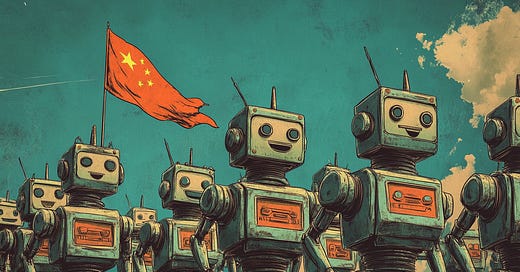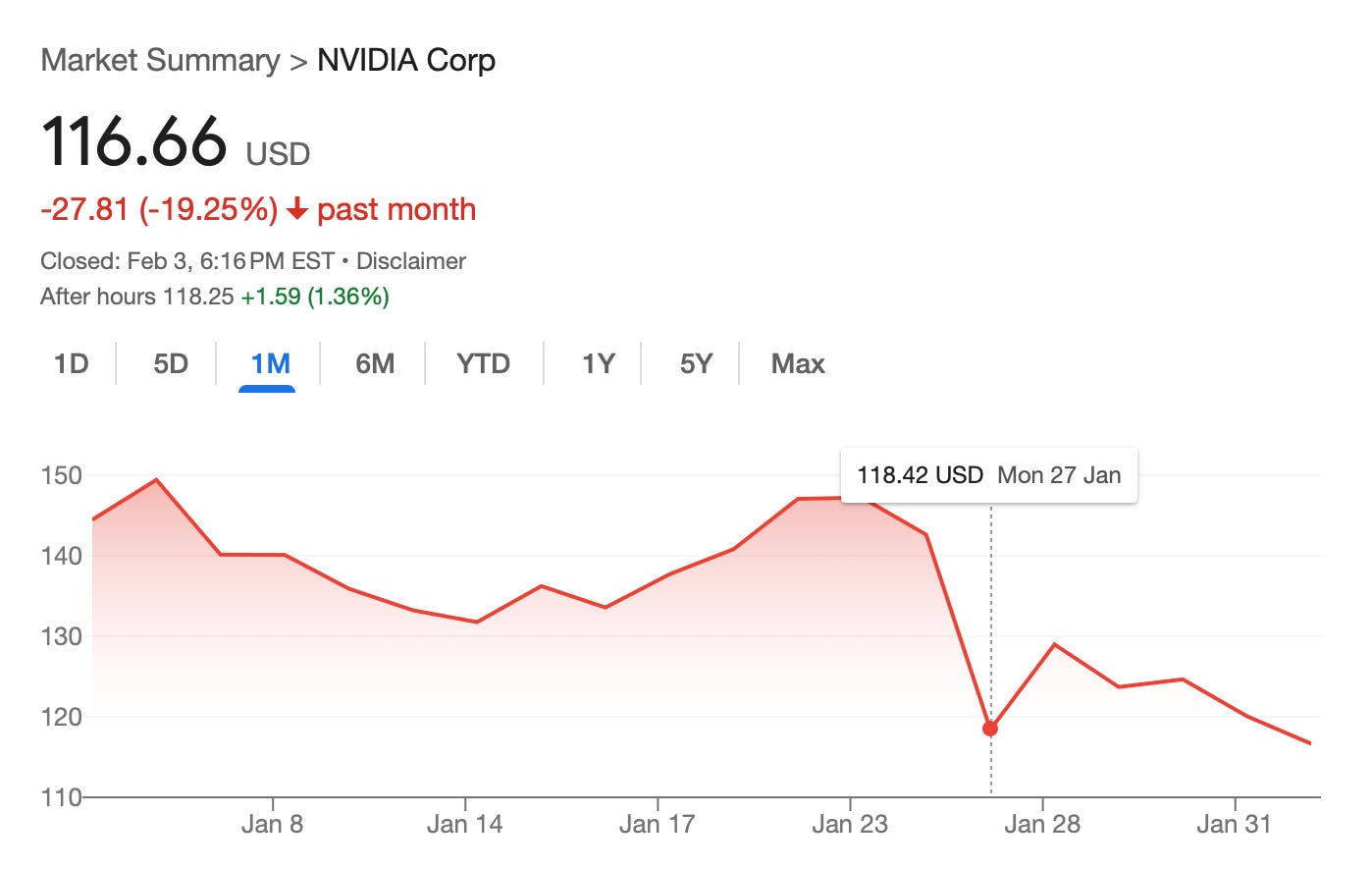DeepSeek: The AI That Rewrote the Rulebook
How a Chinese company challenged the status quo and opened new possibilities for everyone
To train an artificial intelligence model, you need chips. Thousands of chips. Think of them as the brain of AI: the more chips you have and the more powerful they are, the faster your model will "learn."
Until recently, tech giants were locked in a competition to see who could deploy more processors. Meta, the company that owns Facebook, announced plans for a data center with 350,000 chips to train its models. Microsoft and Google aren't far behind, pouring billions into Nvidia chips – the company that makes the best "brains" for AI.
And then DeepSeek burst onto the scene...
Meet DeepSeek
This Chinese company just unveiled their new AI model, DeepSeek-V3, which can match everything the world's best models can do. The mind-blowing part? They did it using only 2,000 chips. It's as if someone figured out how to create an Oscar-winning blockbuster on a TV commercial budget.
How did they pull this off? Not by using more powerful chips (in fact, due to U.S. restrictions, they couldn't even access the top Nvidia processors). Their approach was brilliantly simple: they found ways to make each chip work smarter, not harder.
Think about it like solving a complex math problem. Some parts require you to be super precise with every decimal place, while in others, rounding numbers won't affect your final answer. DeepSeek applied this exact principle: they used precise calculations only when truly necessary, conserving processing power everywhere else.
But they didn't stop there. They also revolutionized how chips communicate with each other. Imagine the difference between a chaotic conversation where everyone speaks simultaneously versus an orchestrated discussion where each participant knows exactly when to contribute and what to say.
The result? An AI model that costs roughly $6 million to train, compared to the hundreds of millions that other companies are burning through.
The Thinking Machines
But there's more to the story. DeepSeek has also unveiled DeepThink (R1), their reasoning-focused AI. Unlike conventional systems that jump straight to answers, R1 reveals its step-by-step thinking process – a feature I love ❤️.
Let me show you how it works: When I ask "Tell me about yourself," the system first analyzes:
That the question is in Spanish and requires a response in the same language
How to structure its reply, choosing to begin with a greeting
What relevant information about itself would be most helpful to share
The appropriate tone, selecting a friendly and accessible approach
Ensuring the response is properly formatted in Spanish and free of errors
Notice everything it considers before responding. This gives us a rare glimpse into the AI's cognitive process – something that until now remained hidden in a "black box."
I've been experimenting with this technology recently, and while I still need more testing time, I'm fascinated by the ability to witness exactly how the AI formulates its thoughts before delivering an answer.
The Market Earthquake
This news shook the tech world like a magnitude 9 earthquake. Remember Nvidia, the company I mentioned earlier? Their stock plummeted, wiping out $600 billion in a single day (for perspective, that's more than Netflix and Adobe's combined market value).
Why all the drama? Because DeepSeek just accomplished with 2,000 processing units what others do with hundreds of thousands. It's like discovering you can create a five-star restaurant dish using everyday ingredients and the right technique – suddenly, everyone questions why they've been spending fortunes on fancy equipment.
The domino effect was immediate. Consider the ripple effects: needing fewer computational resources to train AI also means less energy consumption and reduced infrastructure requirements. Companies throughout the supply chain felt the tremors. Siemens Energy, which manufactures data center infrastructure, watched their shares tumble. Even Cameco, which produces uranium for nuclear plants powering these computing facilities, took a hit.
Funny enough, companies like Apple, which got criticized for not spending as much on AI as their competitors, might have been right all along. While others were in a spending frenzy for more hardware, Apple was focusing on getting the most out of what they had.
For the last couple of years, tech giants have been locked in a spending war, competing to see who could deploy more processing hardware and bigger data centers. What DeepSeek has demonstrated is something revolutionary: there's a smarter path forward.
Of course, there's an important distinction to make: while fewer computational resources are needed to train these AI systems, these same resources are still necessary to run them. As AI adoption continues to spread among individuals and businesses, demand for processing capacity will likely keep growing. The key difference is that now we know this hardware can be utilized far more efficiently.
AI Within Everyone's Reach
Why should this matter to you and me? Because when something becomes cheaper to produce, it suddenly becomes accessible to many more people. Consider this practical example: when DeepSeek's AI processes text (what insiders call "tokens"), it charges just $1 per million tokens. Meanwhile, Anthropic, the company behind Claude, charges $15 for the exact same processing. It's like discovering you can enjoy a business-class experience while paying economy prices.
This changes everything. Until now, creating and using advanced AI was exclusively the domain of corporations with multi-million dollar budgets. Suddenly, we're looking at a future filled with new possibilities: small businesses developing specialized AI assistants tailored to their unique needs; developing nations implementing AI solutions to transform education and healthcare; innovators with brilliant ideas but limited resources finally getting a seat at the table.
And we're just witnessing the first ripples of this wave. If DeepSeek could discover this path to efficiency, other companies will surely follow. We might soon see an innovation race where success comes not from having the deepest pockets, but from using resources most intelligently.
The true revolution, though, extends far beyond the financial districts and tech hubs. History has shown us time and again: when technology becomes significantly more efficient and affordable, it unlocks applications and opportunities that nobody had even imagined yet.
But wait, there's more! (Forgive the infomercial tone – I couldn't resist): DeepSeek has taken the extraordinary step of sharing their model with the entire world. Not only can you freely download and use it, but they've also provided detailed explanations of how everything works. This stands in stark contrast to companies like OpenAI, which guard their models like classified state secrets. This radical transparency could speed up AI advancement, allowing researchers and developers everywhere to team up and build on these breakthroughs.
The impact goes way beyond what we can imagine today. University researchers can now play with cutting-edge AI without worrying about their budget. Startups can create specialized apps without needing millions in funding first. Even governments can use AI in public services without having to choose between new technology and other basic public needs.
Some critics have taken aim at DeepSeek, claiming they've borrowed elements from American models (which OpenAI says violates their terms of service). But honestly, that debate doesn't matter much anymore – what's important is that we now know there's another way to create and share AI technology.
And this matters because for years, major AI labs in the United States have been caught in a race to make incremental improvements to their models, spending more and more money with each iteration. DeepSeek shows there's another way forward.
AI is breaking free from being a luxury that only companies with massive data centers can afford. It's transforming into something as fundamental as electricity or internet access. And just like with every technology that becomes widely accessible, the most exciting part isn't what we can picture today, but all the unexpected innovations people will create once they get their hands on it.
What Comes Next?
This shift challenges the entire approach to AI development. Instead of a handful of tech giants controlling the direction of artificial intelligence through their enormous resources, we could see innovation coming from anywhere – universities, independent researchers, startups in unexpected places, or even passionate individuals working from their homes.
The technology world has been operating under the assumption that bigger is always better – more computing power, larger datasets, and bigger teams. DeepSeek's breakthrough suggests that clever engineering and efficiency might matter more than raw resources. This could reshape how we think about technology development across the board.
When anyone can access powerful AI tools without needing a tech giant's budget, the whole game changes. Who knows what amazing things people will create? A student in a small town, a doctor in a developing country, or maybe you with your unique perspective – that's the truly exciting part of this story!
G
Hey! I'm Germán, and I write about AI in both English and Spanish. This article was first published in Spanish in my newsletter AprendiendoIA, and I've adapted it for my English-speaking friends at My AI Journey. My mission is simple: helping you understand and leverage AI, regardless of your technical background or preferred language. See you in the next one!







